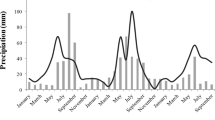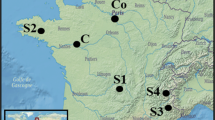Abstract
Five single-treatment methods used to stabilize seeded areas at urban and highway construction sites (asphalt-tacked straw, jute netting, mulch blanket, wood chips, excelsior blanket) were tested for their ability to control erosion of red clay soils by comparisons with exposed sites and multiple treatments. Sediment in runoff from experimental plots was characterized during low and high intensity precipitation from natural rainfall episodes during April, May, and June. Reductions in the total sediment concentration of runoff ranged from 28 percent (asphalt-tacked straw, 50 percent slope) to 90 percent (multiple treatments, 40 percent slope), with ≥85 percent of the eroded material composed of particles <0.04 mm in diameter. Larger size fractions were effectively reduced by all treatments tested regardless of slope (≥70 percent decrease). Established grass cover exceeded 90 percent on all plots after 60 days, but sediment release remained similar, attributable to high intensity rainfall, poor establishment of root systems, and piping on plots treated with tacked straw or jute netting. Results indicate that current stabilization methods shift sediment compostion toward a smaller particle size, causing single treatments to be minimally effective for controlling erosion of the major component of red clay soils. Because small particles have the greatest direct effect on aquatic biota, certain impacts of sedimentation may not be measurably lessened by single treatments in regions where red clays predominate even though the total sediment load is reduced by as much as 75 percent. Clearly, a multiple-treatment approach offers significantly greater control of erosion on red clay soils, however, current economic and construction policy represents a substantial deterrent to implementation.
Similar content being viewed by others
Literature cited
Barfield, B., D. T. Y. Kayo, and E. W. Tollner. 1975. Analysis of sediment filtering action of grassed media. Research Report No. 90, University of Kentucky Water Resources Research Institute, Lexington, KY. 50. pp.
Barton, B. A. 1977. Short-term effects of highway construction on the limnology of a small stream in southern Ontario.Freshwater Biol. 7:99–108.
Becker, B. C., and T. R. Mills. 1972. Guidelines for erosion and sediment control planning and implemetation. EPA-R2-72-0105, US Environmental Protection Agency, Washington, DC. 228 pp.
Bhutani, J., R. Holberger, and P. Spewak. 1975. Impacts of hydrologic modifications on water quality. EPA-600/2-75-007, US Environmental Protection Agency, Washington, DC. 531 pp.
Brandt, G. H. 1972. An economic analysis of erosion and sediment control methods for watersheds undergoing urbanization. Dow Chemical Co. Report No. W72-08236/PB-209-212. 46 pp.
Burns, J. W. 1970. Spawning bed sedimentation studies in northern California streams.Calif. Fish Game 56:253–270.
Chisholm, J. L., and S. C. Downs. 1977. Stress and recovery of aquatic organisms as related to highway construction along Turtle Creek, Boone County, West Virginia. USGS Water Supply Paper No. 205, Washington DC. 19 pp.
Chutter, F. M. 1969. The effects of silt and sand on the invertebrate fauna of streams and rivers.Hydrobiologia 34:57–76.
Cordone, A. J., and D. W. Kelley. 1961. The influence of inorganic sediment on the aquatic life of streams.Calif. Fish Game 47:189–228.
Curry, R. R. 1975. Limiting downstream effects of watershed manipulation: A proposed NEPA guideline. Pages 251–262in R. K. Sharma (ed.), Biological effects of environmental impacts. NR-CONF-002, Washington, DC.
Daniel, T. C., and P. E. McGuire, D. Stoffel, and B. Miller. 1979. Sediment and nutrient yield from residential construction sites.J. Environ. Qual. 8:304–308.
Diseker, E. G., and E. C. Richardson. 1961. Control of roadbank erosion in the sourthern Piedmont.Agron. J. 53:292–294.
Diseker, E. G., and E. C. Richardson. 1962. Erosion rates and control methods on highway cuts.Trans. Am. Soc. Arg. Eng. 5:153–155.
Ellis, M. M. 1936. Erosion silt as a factor in aquatic environments.Ecology 17:29–42.
Extence, C. A. 1978. The effects of motorway construction on an urban stream.Environ. Pollut. 17:245–252.
Farnworth, E. G., M. C. Nichols, and C. N. Vann. 1979. Impacts of sediment on nutrients and biota in surface waters of the United States. EPA-600/3-79-105, US Environmental Protection Agency, Washington, DC. 315 pp.
Gammon, J. R. 1970. The effect of inorganic sediment on stream biota. EPA Water Pollution Control Series 18050DWC12/70. 141 pp.
Hausle, D. A., and D. W. Coble. 1976. Influence of sediment in redds on survival and emergence of brook trout,Salvelinus fontinalis.Trans. Am. Fish. Soc. 105:57–63.
Hendrickson, B. H., and A. P. Barnett. 1963. Runoff and erosion control studies on Cecil soil in the southern Piedmont. USDA, Agr. Res. Serv. Tech. Bull. No. 1281, Washington, DC. 23 pp.
Herschfield, D. M. 1961. Rainfall frequency atlas of the United States for durations from 30 minutes to 24 hours, and return periods from 1 to 100 years. US Weather Bureau Tech. Rep. No. 40, Washington, DC. 316pp.
Holberger, R. L. and J. B. Truett. 1976. Sediment yield from construction sites. Pages 47–58in Proceedings of the 3rd Federal Inter-agency Sediment Conference, Denver, CO.
Horkel, J. D., and W. K. Pearson. 1976. Effects of turbidity on ventilation rates and oxygen consumption of green sunfish,Lepomis cyanellus.Trans. Am. Fish. Soc. 105:107–113.
Hotes, F. L. 1973. Comparative costs of erosion and sediment control for construction activities. EPA-430-9-73-016, US Environmental Protection Agency, Washington, DC. 78 pp.
Hynes, H. B. N. 1970. The ecology of running waters. Liverpool University Press, Liverpool. 555 pp.
Jamison, V. C., D. C. Smith, and J. F. Thorton. 1968. Soil and water research on a claypan soil. USDA Tech. Bull. 1379, Washington, DC. 41 pp.
Kayo, D. T. Y., B. J. Barfield, and A. E. Lyons. 1975. On site sedimentation filtration using grass strips. Pages 73–82in D. T. Y. Kayo and R. W. DeVore (eds.), National symposium on urban hydrology and sediment control. University of Kentucky, Lexington, KY.
Lemly, A. D. 1982. Modification of benthic insect communities in polluted streams: Combined effects of sedimentation and nutrient enrichment.Hydrobiologia 87:229–245.
McClelland, W. T. 1972. The effects of introduced sediment on the ecology and behavior of stream inserts. Ph.D. dissertation, University of Idaho, Moscow, ID. 167 pp.
Morisawa, M. 1968. Streams: their dynamics and morphology. McGraw-Hill Book Co., New York, NY. 175 pp.
Ohlander, C. A. I976. Defining the sediment trapping characteristics of a vegetative buffer. Special cases: road construction. Pages 77–82in Proc. of the 3rd Federal Interagency Sediment Conference, Denver, CO.
Piest, R. F. 1963. The role of the large storm as a sediment contributor. Pages 98–108in Proc. Fed. Inter-agency Sedimentation Conf., Misc. Pub. No. 970, Washington, DC.
Putnam, A. L. 1972. Effect of urban development on floods in the Piedmont province of North Carolina. US Geological Survey Open File Report No. 1134-89. 87 pp.
Reed, J. R. 1977. Stream community response to road construction sediments. Virginia Water Resources Research Center Bull. No. 97. 61 pp.
Reeder, H. E. 1973. Sediment resulting from construction of an interstate highway in the Piedmont area of North Carolina. US Geological Survey Open File Report No. 2136-119. 64 pp.
Rohlf, F. J., and R. R. Sokal. 1969. Statistical tables. W. H. Freeman and Co., San Francisco, CA. 253 pp.
Saunders, J. W., and M. W. Smith. 1975. Changes in stream populations of trout associated with increased silt.J. Fish. Res. Board Can. 22:395–404.
Sokal, R. R., and F. J. Rohlf. 1969. Biometry. W. H. Freeman and Co., San Francisco, CA. 776 pp.
State of California. 1970. Bank and shore protection in California highway practice. State of California, Division of Highways, Sacramento, CA. 188 pp.
Swenson, W. A., L. T. Brooke, and P. W. Devore. 1976. Effects of red clay turbidity on the aquatic environment. Pages 207–230in EPA-905/9-76-005, US Environmental Protection Agency, Chicago, IL.
Swerdon, P. M., and S. R. Kountz. 1973. Sediment runoff control at highway construction sites. Eng. Res. Bull. No. B108, Pennsylvania State University, University Park, PA. 123 pp.
Taylor, C. R., D. R. Reneau, and B. L. Harris. 1978. An economic analysis of erosion and sedimentation in Lavon Reservoir watershed. Texas Water Resources Institute Bull. No. TR-88, College Station, TX. 32 pp.
Thomas, N. O., and W. G. Bonham. 1977. Annual maximum stages and discharges of North Carolina streams. North Carolina Dept. Natural and Economic Resources Open File Report No. 77-367, Raleigh, NC. 226 pp.
Trollner, E. W., B. J. Barfield, and C. T. Horn. 1975. Vegetation as a sediment filter. Pages 61–64in D. T. Y. Kayo and R. W. Devore (eds.), National symposium on urban hydrology and sediment control. University of Kentucky, Lexington, KY.
US Department of Agriculture. 1969. Standards and specifications for soil erosion and sediment control in urbanizing areas. USDA, Soil Conservation Service, College Park, MD. 312 pp.
US Department of Agriculture. 1974. Controlling erosion on construction sites. USDA, Soil Conservation Service, Agriculture Information Bull. No. 347.45 pp.
US Department of Agriculture. 1975. Sediment pollution and erosion control guide for resource conservation. USDA, Soil Conservation Service, Tech. Guide No. 31, Washington DC. 69 pp.
Vice, R. B. 1973. Sediment movement in an area of suburban highway construction, Scott Run Basin, Fairfax County, Virginia, 1961–1964. US Geological Survey Water Supply Paper No. 1519-E. 21 pp.
Watson, V. J., O. L. Loucks, and W. Wojner. 1981. The impact of urbanization on hydrologic and nutrient budgets of a small watershed.Hydrobiologia 77:87–96.
Whipple, W., J. M. Dilouie, and T. Pytlar. 1981. Erosional potential of streams in urbanizing areas.Water Resour. Bull. 17:36–45.
White, C. S. 1976. Factors influencing natural water quality and changes resulting from land use practices.Water, Air, Soil Pollut. 6:53–69.
Wolman, M. G., and A. P. Schick. 1967. Effects of construction on fluvial sediment in urban and suburban areas of Maryland.Water Resour. Res. 3:451–464.
Yorke, T. H., and W. J. Davis. 1972. Sediment yields of urban construction sources, Montgomery County, Maryland. US Geological Survey Report Y-918, Rockville, MD.
Author information
Authors and Affiliations
Rights and permissions
About this article
Cite this article
Lemly, A.D. Erosion control at construction sites on red clay soils. Environmental Management 6, 343–352 (1982). https://doi.org/10.1007/BF01875066
Issue Date:
DOI: https://doi.org/10.1007/BF01875066




